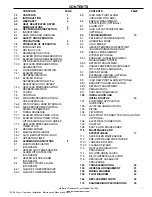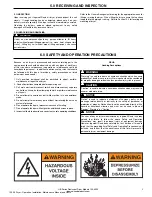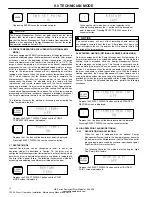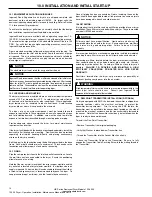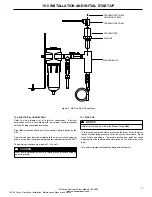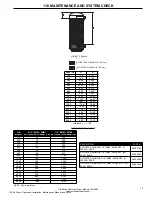
HB Series Desiccant Dryer Models 150-8000
ingersollrandproducts.com
4
7.1 INTRODUCTION
As described in Section 2, water vapor is removed from compressed air
by diverting air flow alternately between two towers filled with activated
alumina desiccant. While one tower processes the compressed air
stream adsorbing water vapor, the opposite tower regenerates by
desorbing the water vapor and venting it to atmosphere.
The Microprocessor Controller provides the ability to select between
blower purge or heatless regeneration. Both blower purge and heatless
regeneration methods are described in the following sections.
A
NOTICE
The Microprocessor Controller must be in the OFF position prior to
changing the mode (blower / heatless) of the dryer. After the change
is made and the Microprocessor Control is subsequently turned ON,
the dryer will be in the new mode of operation.
7.2 DRYING CYCLE
Saturated compressed air enters the dryer and is diverted to the
appropriate tower by the Inlet Flow Valves. (Refer to the Process and
Instrumentation Diagram.) The Right Tower Flow Valve is actuated to a
closed position to prevent air flow from entering the regenerating tower.
Simultaneously, the Left Tower Flow Valve is actuated to an open
position allowing air flow to the drying tower. During this time, the Left
Tower Purge Valve is actuated to a closed position, preventing the
compressed air from venting to atmosphere. As the compressed air
flows through the desiccant material in the left tower at pressure,
removal of water vapor from the air stream begins to occur through
adsorption. In the adsorption process, the desiccant material draws
water vapor out of the compressed air and "holds" it until the left tower
drying cycle is complete. Compressed air flows out of the tower for
delivery to the process use. The Outlet Flow Check Valves provide air
flow diversion to the outlet air connection of the dryer.
7.3 REGENERATION CYCLE
Previously adsorbed moisture removed from the process stream gets
stripped or desorbed from the desiccant material in the regeneration
process. The first stage of regeneration is tower de-pressurization.
After the Inlet Flow Valves are switched to divert air flow away from the
regenerating tower, the Depressurization Valve opens and the tower will
be depressurized. Through depressurization, a significant portion of the
previously adsorbed water vapor is stripped off of the desiccant material
and exhausted to atmosphere.
A
CAUTION
Any time the dryer is switched between two operating modes, care
must be taken to ensure the purge adjustment valve is adjusted
correctly. Refer to the specification sheet in this manual for proper
gauge setting.
7.3.1
BLOWER PURGE REGENERATION
In the blower mode, there is no dry compressed air used for
regeneration. Ambient air is drawn into the blower intake and
then discharged through the purge heater and through the
regenerating tower. After tower depressurization, the heater
and blower operate for 3 hours, 44 minutes. The blower
continues to operate for ten minutes to cool the heater
element.
7.3.2
BLOWER PURGE REGENERATION WITH SELECTABLE
COOL SWEEP
With the Cool Sweep feature, which uses a portion of dried
compressed air to cool the bed at the end of the regeneration
cycle, the heater and blower operate for 2 hours and 57
minutes. The blower continues to operate for an additional ten
minutes to cool the heater. The Repressurization Valve is then
opened, allowing dry compressed air to pass through the
regenerating tower for 48 minutes.
7.0 PRINCIPLES OF OPERATION
7.3.3
HEATLESS PRESSURE SWING REGENERATION
In the heatless mode, following depressurization,
regeneration uses approximately 15% of the dry compressed
air, expanded to atmospheric pressure to complete the
desorption process. As shown on the P & ID, the compressed
air exits the drying tower and a portion of the air flows through
the Purge Adjustment Valve and the Purge Orifice. Once the
air has passed through the Purge Orifice, it expands to
atmospheric pressure and continues the regeneration
process. Desorption occurs as the desiccant releases water
vapor into the regeneration air and is exhausted through the
Purge Valves. Note that in the Heatless Pressure Swing
Mode, proper setting of the purge flow is necessary to achieve
optimum dryer performance. Setting the purge flow too high
will waste compressed air and if set too low, the dryer will not
achieve dew point performance. The purge adjustment
manifold consists of the purge adjustment valve, purge
pressure gauge, and the purge orifice. Manually adjust the
purge adjustment valve until the reading on purge pressure
gauge matches the purge pressure setting listed on the tag
attached to the gauge.
A
NOTICE
When operating dryer in standard Blower Purge mode, dryer may
exhibit high discharge temperatures at tower switchover (300 °F) and
dew point spikes (+20°F). This is considered normal operation for this
equipment. Operator must insure that equipment located downstream
of dryer be capable of tolerating these conditions.
7.4 TOWER REPRESSURIZATION
Upon completion of tower regeneration, and prior to changing the Inlet
Flow Valve position to switch towers, the regenerated tower must be
repressurized.
A
NOTICE
Failure to repressurize prior to tower switchover will result in shocking
the desiccant material and cause premature desiccant dusting.
7.4.1
BLOWER PURGE REPRESSURIZATION
Three minutes prior to tower switch-over, the blower will be
shut off and the Purge Valves and Depressurization Valves
will close. The Repressurization Valve will then open,
allowing air from the outlet of the dryer to pressurize the tower
prior to switch-over. During normal tower regeneration, the
Repressurization Valve is closed, so that the blower supplies
the only source of regeneration air.
7.4.2
BLOWER PURGE REPRESSURIZATION WITH
SELECTABLE COOL SWEEP
Three minutes prior to tower switch-over, the Purge Valves
and Depressurization Valves will close. The Repressurization
Valve will then open, allowing air from the outlet of the dryer
to pressurize the tower prior to switch-over.
7.4.3
HEATLESS PRESSURE SWING REPRESSURIZATION
45 seconds prior to tower switch-over, repressurization is
accomplished by closing the appropriate Purge Valve and the
Depressurization Valve. When the Purge Valve closes, the
regeneration air begins to pressurize the tower. In addition,
the Repressurization Valve opens, allowing additional air from
the outlet of the dryer to assist the purge air and to ensure
adequate pressurization. During normal tower regeneration,
is held closed so that the only source of air for regeneration
passes through the purge adjustment assembly.
120.26 Dryer - Operation, Installation, Maintenance Manual, and Parts



